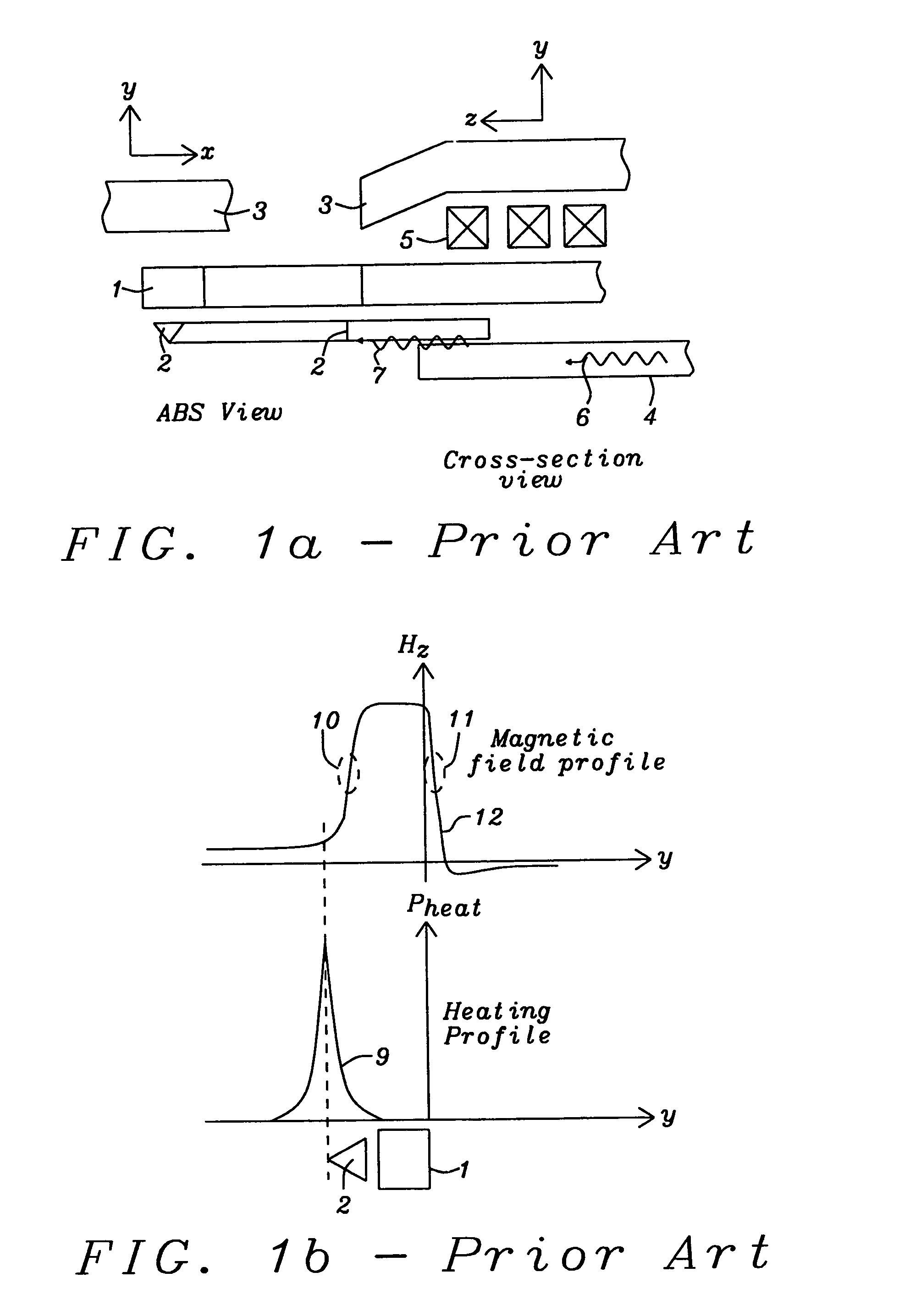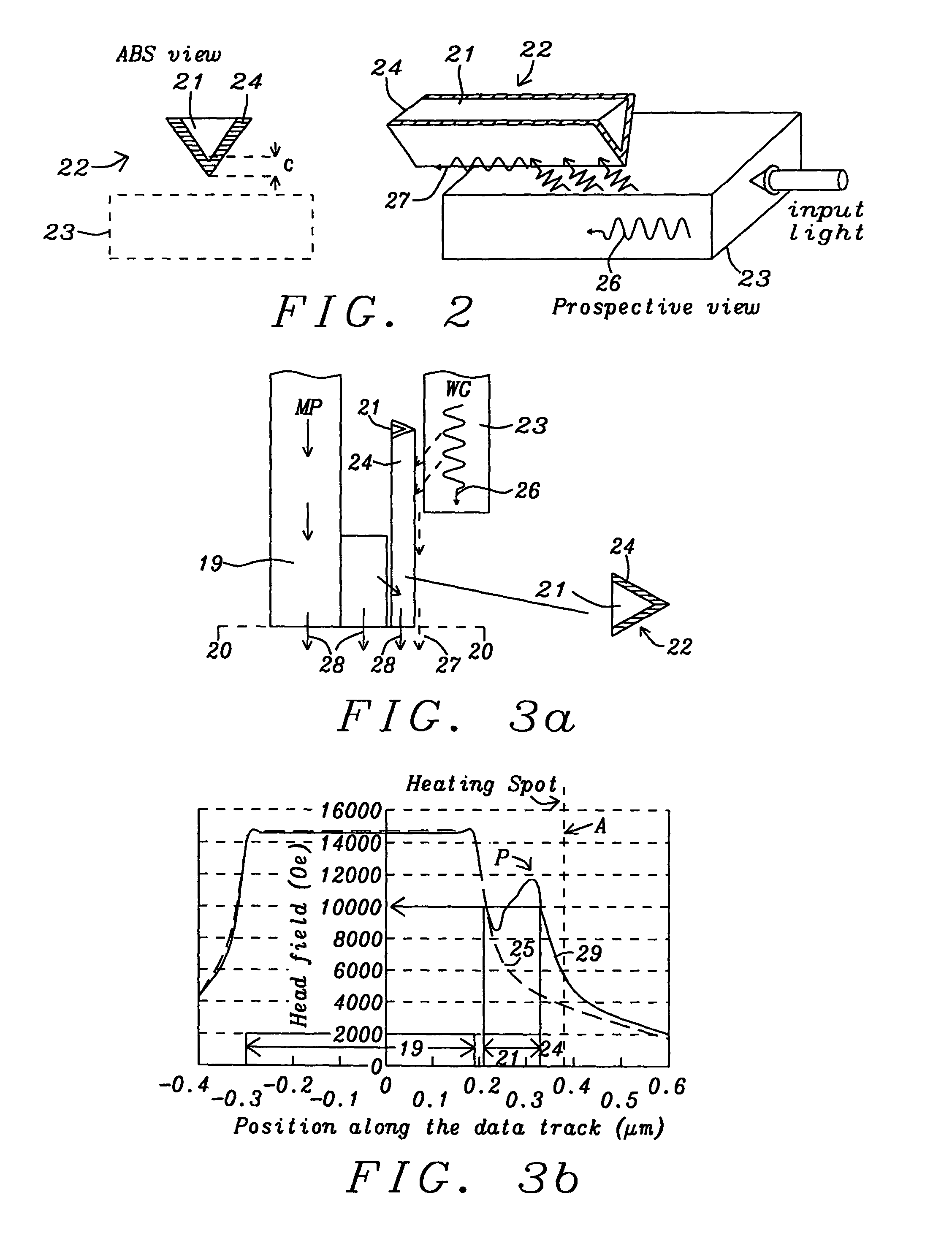Magnetic core plasmon antenna with recessed plasmon layer
a plasmon layer and magnetic core technology, applied in the direction of perpendicular magnetisation head, record information storage, instruments, etc., can solve the problem of not being able to achieve the most desired condition for tamr writing, the objective of correctly aligning the optical heating profile with the magnetic field profile is not adequately addressed, and the alignment is difficult to achiev
- Summary
- Abstract
- Description
- Claims
- Application Information
AI Technical Summary
Benefits of technology
Problems solved by technology
Method used
Image
Examples
first embodiment
[0037]Referring to FIG. 5a, a TAMR head including a MCA configuration with a recessed PG layer 32 is shown from a side view (top) and an ABS view (bottom) according to the present invention. In the drawings depicted hereinafter, the x-axis refers to the cross-track direction, the y-axis is the down-track direction, and the z-axis arrow points toward a back end of the device. Main pole 31 is comprised of a magnetic material and has an end 31p called a pole tip along the ABS 30-30. Write pole 31p has an edge 31b on a first main pole side that is adjacent to an MCA which includes a PG layer 32 and a magnetic core (not shown in the side view). There is also an edge 31a on a side of the main pole opposite the first side. The PG layer 32 is a non-magnetic material comprised of one or more of Au, Ag, Cu, Al, Ti, Ta, and Ge with a thickness from about 10 to 100 nm. In this embodiment, the MCA has a triangular shape from an ABS view and the PG layer 32 is recessed by a distance “s” of 5 to 1...
second embodiment
[0046]Referring to FIG. 11, an alternative version of the second embodiment is depicted. All components previously described with respect to FIGS. 6a-6b are retained in FIG. 11 except the end 32e of PG layer 32 is replaced with a sloped side 32s that connects a top edge 32t to vertex 32v. Instead of having top edge 32t and vertex 32v recessed essentially an equal distance from ABS 30-30 in FIG. 6b, top edge 32t is recessed a greater distance from the ABS than vertex 32v in the B-B cross-sectional view (FIG. 11). From an ABS view, magnetic layer 33e continues the triangular shape of the MCA from side 32s to the ABS and transmits the plasmon mode from the PG layer 32 to the ABS while simultaneously transmitting magnetic flux from main pole 31 and magnetic core 33 to the ABS 30-30 and magnetic medium (not shown).
[0047]Referring to FIG. 12, a third embodiment of the present invention is shown that represents a modification of the first embodiment depicted in FIG. 10. In particular, a ma...
fifth embodiment
[0049]Referring to FIG. 14, the present invention is depicted and represents a modification of the TAMR structure shown in FIG. 10. All components previously described with respect to FIG. 10 are retained in FIG. 14 except the shape of the magnetic layer 31e is changed from an ABS view. In particular, the triangular shape of the magnetic layer is replaced by a trapezoid shape that is larger than the triangular MCA shape. A first side of the magnetic layer 31e interfaces with a side of the main pole 31 that includes edge 31b and is formed in a first plane (not shown) that extends in the z-axis direction from the ABS and includes a side of the PG layer 32 opposite vertex 32v. The first side has a width in a cross-track direction that is essentially the same as that of edge 31b. A side 31c of the magnetic layer 31e opposite edge 31b is formed along a second plane which is parallel to the first plane and includes vertex 32v. Side 31c preferably has a greater width along the cross-track ...
PUM
 Login to View More
Login to View More Abstract
Description
Claims
Application Information
 Login to View More
Login to View More - R&D
- Intellectual Property
- Life Sciences
- Materials
- Tech Scout
- Unparalleled Data Quality
- Higher Quality Content
- 60% Fewer Hallucinations
Browse by: Latest US Patents, China's latest patents, Technical Efficacy Thesaurus, Application Domain, Technology Topic, Popular Technical Reports.
© 2025 PatSnap. All rights reserved.Legal|Privacy policy|Modern Slavery Act Transparency Statement|Sitemap|About US| Contact US: help@patsnap.com



